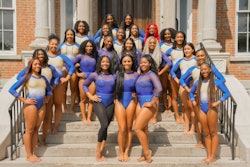Like former talk-show host Arsenio Hall, Kenneth
L. Shropshire, in his excellent book, In Black and
White: Race and Sports in America, discusses
things that make you go “HMMMMM?”
Unlike
Hall, Shropshire not only makes you ponder,
he offer insightful history and provocative
analysis for why the sports world in America is
so Black and white. He also provides a decisive
course of action for narrowing the racial disparities
which permeate that world.
Indeed, Shropshire says his goal in writing the book “was
to focus on even-handed methods of addressing a continuing
problem that likely will not disappear.” But
he also makes a concerted effort to explain
why change is so important.
He sets up his case quite nicely with an
introduction that examines the realities of
racism and discrimination in this country,
conceding that both are as American as apple
pie. Shropshire deftly uses statistics to
support his case, but he also establishes
three key themes in his analysis of the
sports industry.
The first theme focuses on the impact of
color-blind policies and the failure of such
policies in addressing existing race problems.
The second looks at the need to recognize
that unconscious racism exists in all
America. And his final theme concerns the
permanence of that racism in America. Only
by understanding those concepts can reform
come about, declares Shropshire, who
emphasizes them throughout the hook
Take his historical perspective that examines the rise of
racism and discrimination in sports from its earliest
roots–from mixing of the races in most athletic events, to Jim
Crow segregation; from the breaking of the color barrier by
Jackie Robinson, to the “lawn jockey” mentality that
manifested itself in the racist comments of Al Campanis,
Jimmy “the Greek” Snyder and Marge Schott. According
to Shropshire, that history shows that overwhelming
change has not taken place and that for Blacks to have a
greater role in sports, white people will have to
relinquish power.
So, what would be the primary benefits of minority
ownership in professional sports? First, there is the social
value of diversity. Second, Shropshire writes, there is the
“financial value of diversity, in terms of allowing minorities
access to a piece of the lucrative sports ownership pie and
expanding the individual franchise revenues by attracting more
fan support and attendance from minorities and achieving
equity in player salaries without regard to race.”
Put another way, the author says meaningful
sports-franchise ownership by Blacks would symbolize the
narrowing of race inequity in the sports world and race issues
in America in general. It would negate, to some degree, the last
business in which owners bought, sold and traded people.
HMMMMM?
Shropshire, who is an associate professor of legal studies
at the Wharton School at the University of Pennsylvania and a
practicing sports law attorney, is perhaps at his sharpest
when he discusses legal recourse towards achieving the social,
cultural and financial benefits of diversity. But he admits that
the courts can play only a limited role in mandating diversity
in the front offices of sports franchises, conceding that the law
has played a limited role in discrimination in the private
sector. He therefore advocates the need for voluntary efforts
to dismantle racism and discrimination in the sports world,
placing that burden on league leaders and on athletes to
address change.
“There needs to be a recognition that cooperation, not
conflict, will foster growth and prosperity for all involved,”
Shropshire says. HMMMMM?
But to achieve those benefits, sacrifices will have to be
made. Shropshire eagerly outlines both the sacrifices
and the benefits. He goes on to cite several
forms of affirmative action by professional
amateur, and collegiate sports organizations
which are initiating sports hiring networks.
Shropshire also addresses discrimination
concerns at the collegiate level, most notably
the argument that NCAA academic standards
have a disproportionate impact on African
Americans. And he discusses the exclusions
and limitations Blacks suffer in other areas of
the sports industry, such as selection as
sports agents. He alludes to the “Colder Ice
Syndrome” which justifies the suggestion by
Black athletes that somehow white agents are
better. HMMMMM?
In conclusion, Shropshire says that the
ideal sports industry will only come about
after a couple of things happen. First, there
must be recognition of the existence of racism,
discrimination, and limited access. Next, there
must be a period when the sports world
actively and aggressively adopts policies that
will make racial diversity, the standard. That
period of transition must include many
factors, the author says, challenging the sports
world to move in a positive direction.
“Anyone who can have an impact on the
business of sports has a responsibility to act,”
he writes, “because the way sports
addresses the issues says much about how
other sectors will address inequality in the:
future.”
One interesting side note of the book is
the foreword by Hall-of-Fame football player
Kellen Winslow, who provides an interesting,
first-person perspective on the necessity of
Shropshire’s book. Winslow who was a
dazzling performer during his nine-year
National Football League career, realized after
he stepped into the real world that he was just
another person of African American descent.
Retiring from the San Diego Chargers in 1988,
Winslow had hoped for a job in the front
office of the team he had served so well. No
opportunities were made available for him.
In 1993, the position for athletic director
opened up at his alma mater, the University
of Missouri, and he was asked by the search
committee to submit an application. He was
passed over, but more disappointing was the
fact that he was informed of the decision
twenty minutes before the new AD was
named.
“I cannot shake the feeling that with all I
brought to the table–a law degree; practical
business experience; my status as a former
student athlete, a collegiate All-American, and
an alumnus; my stellar professional career;
leadership skills; a bit of charisma; a command
of the English language–that, if I were white,
the job would have been mine to turn down.”
HMMMMM?
Reading Shropshire’s book, you can’t help
but feel that Winslow is right. In Black and
White: Race and Sports in America often reads
like a legal treatise–a systematic
exposition or argument in writing,
including a methodical discussion of the
facts and principles involved and conclusions
reached. Given Shropshire’s background, it is
easy to see why he follows this style and it
lends itself well to his legal discussions.
Although the style may be a little
cumbersome for the average reader, for
those who have an interest in race and
sports, this is a must read.
COPYRIGHT 1997 Cox, Matthews & Associates
© Copyright 2005 by DiverseEducation.com



















